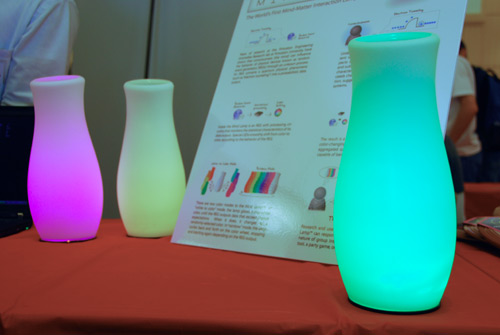
By Evan Ackerman
I stopped by Stanford’s Cool Product Expo yesterday looking for (you guessed it) cool products. And lo and behold, I found some, including this Mind Lamp from a company called Psyleron. It’s called the Mind Lamp because it changes color when you intend it to, based on measurements of quantum level probabilistic events. That’s what they say it does, anyway. I bet you want to know how it works, and I’ll tell you (as best as I can understand it), after the jump.
Firstly, Psyleron was founded in partnership with the Princeton Engineering Anomalies Research lab, which, if they’re a bunch of wackos, are at least wackos with credentials. Answers to common questions about Psyleron’s hardware and data are available in this FAQ, but I’ll lay out the basics:
The Mind Lamp (and all of Psyleron’s technology) operates based on a random event generator. Specifically, Psyleron has a thing that sits in the base of the lamp and measures quantum tunneling electrons, which have a certain quantum probability of passing through a barrier and showing up on a sensor. As long as the sensor only detects random electrons, the lamp will stay one color. If the sensor detects any patterns (more or less electrons than there should be over a given period of time), the lamp will change color. Seems pretty straightforward, right?
Here’s the freaky part: according to Psyleron, empirical data suggests that you can influence the lamp with your mind. That is, if you sit next to the lamp with the intention of changing the color of the lamp, your intention can somehow affect whatever quantum processes are causing electrons to tunnel or not tunnel, the distribution will become less random, and the lamp will change color.
Psyleron has no idea how this happens, or why this happens. All they’re saying is that statistically, according to their data, it does happen. Statistically, if you intend to change the color of the lamp, it is more likely than not that the color of the lamp will change.
Do I believe any of this stuff? Not really, no. I haven’t read any papers from Psyleron or anything, but this effect cannot be tested directly because it doesn’t work much of the time, and that makes me inherently skeptical… It just seems to work more often than than it should. Psyleron says that when people try the lamp, they are often amazed by how well it works, but I tend to think that people will see it working because they want to see it working.
If you’re skeptical but curious, Psyleron has a similar service that you can try for free. It’s called SyncTXT. You set up some text alerts on the Psyleron website, things like “good idea” or “don’t do that.” Then, Psyleron uses a random event generator which sends you one of your messages if or when it detects a particular statistical pattern. Psyleron says that “a large subset” of users of the service have reported “meaningful experiences that challenge their conventional views about the world.” That may be true, but with an ambiguous enough message, it’s not that hard to turn just about anything into a meaningful experience.
The Mind Lamp is available now for $150, and the SyncTXT service costs $6.50 a month but you can try it for a week for free.





Wow it really works .. I just got a call from the guys at Psyleron telling me to shut up since they read my mind when I thought their product sucked.
These kinds of devices have been around as long as the perpetual motion ones… Lots of hot air, non-testable claims and money involved. And credentials aren't worth anything these days, when university financial CEO's measure sucess in income and patents, and have no clue what is science and what is blatant lies…
The research on the PEAR web page is actually pretty interesting, if you can get through the technical jargon …
Sounds more like a social experiment to dress up a $5 dollar turd in a tux and charge $150 for a 'lamp' that provides no functional lighting. Seems every generation needs its 'sea monkies' for sale .. the only thing thats changed is the sticker price.
I suggest that before people lump PEAR in with Perpetual Motion, that they at least READ some of the background on the project and research that has been done. This is VERY thorough statistical and experimental design with many controls and calibration procedures. The lamp mentioned above is simply a popularization of some of the effects and is in no way as rigorous as their experiments. Their excellent book “Margins of Reality” is well worth the time.
Here's more info about Mind Lamp: http://www.mind-matter-effect.com/mind-lamp.html
Here's more info about Mind Lamp.